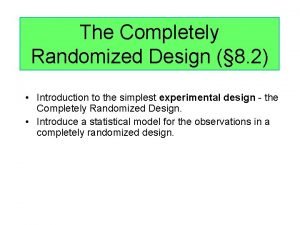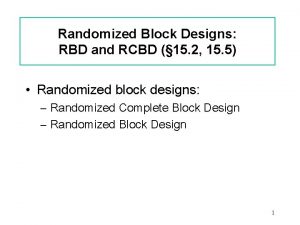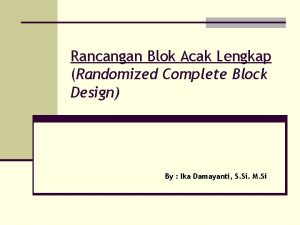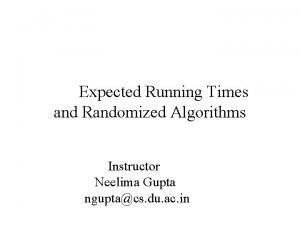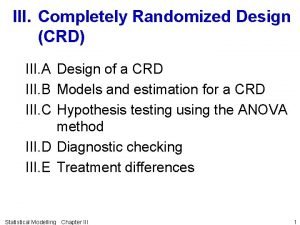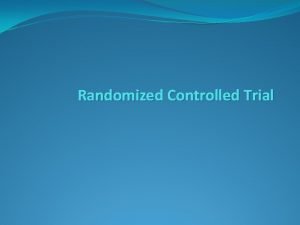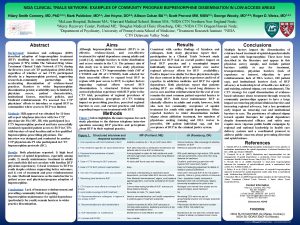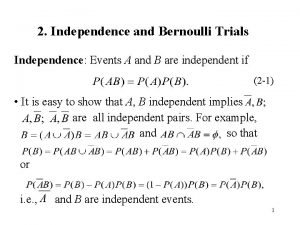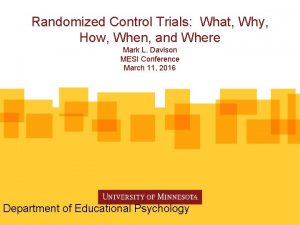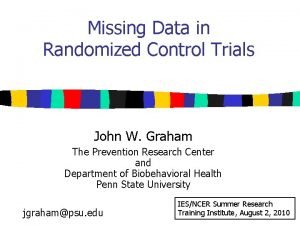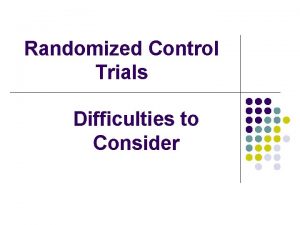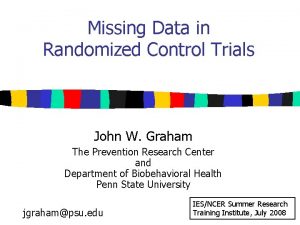Strategies and Challenges in Conducting Randomized Control Trials









































- Slides: 41

Strategies and Challenges in Conducting Randomized Control Trials (RCTs): Experiences from the PACT Evaluation Fatherhood Research and Practice Network Webinar March 3, 2015 Heather Zaveri, Scott Baumgartner, Robin Dion, Sarah Avellar, and Reggie Covington (Mathematica Policy Research) Guy Bowling (Goodwill/Easter Seals of MN) Brandi Jahnke (Connections to Success)

Today’s Speakers Robin Dion PACT Project Director Sarah Avellar Lead on PACT Impact Study Guy Bowling FATHER Project Goodwill/Easter Seals Heather Zaveri PACT Deputy Project Director Brandi Jahnke Connections to Success 2

Webinar Structure • Overview of PACT • Brief description of participating programs • Setting the stage for a rigorous evaluation • Getting fathers in the door • Providing services • Keeping men engaged 3

PACT: A Foundation for Informing RF Field • Process: How were PACT programs designed and implemented? • Impact: Do programs improve outcomes for enrolled fathers? • Qualitative Study: How do fathers view and carry out their roles of parents, providers, and partners? • Descriptive Study of Hispanic Programs: What makes fatherhood programs serving Hispanic men culturally-sensitive? 4

Process, Impact, and Qualitative Components • Mixed-method process study (informs today’s presentation) – Staff interviews and web survey – Enrollment and participation data – Focus groups with participating fathers • Experimental impact evaluation – Fathers complete baseline interview and are randomly assigned to the program or a control group that can receive other community services (the counterfactual) – Twelve month follow-up survey with fathers in both groups – Administrative data on fathers from NDNH • Longitudinal, in-depth, in-person semi-structured interviews with fathers (“qualitative study”) 5

Selected Programs Met Criteria for Rigorous Evaluation • Size • Ability to be pooled with other programs – Large enough to meet statistical – Provide content in the same core power expectations areas – Excess demand for services to – Point of random assignment enable enrollment in a control group • Intervention strength and counterfactual – Offer parenting, relationship, and economic stability services that met a minimum threshold – Strong counterfactual 6

Programs Agreed to Selected Evaluation Activities Program Conducts Conduct outreach to identify interested fathers X Describe program and random assignment to interested fathers X Connect fathers to interviewer for baseline survey X Mathematica Conducts Obtain verbal consent and conduct baseline survey X Conduct random assignment X Serve program group fathers and track their participation X Support program delivery (including recruitment/retention) through monitoring and technical assistance X Locate fathers and conduct follow-up survey X Analyze data and report results X 7

Four Responsible Fatherhood Programs in the PACT Evaluation 8

Integrated Cohort Approach • Successful STEPS Program, Connections to Success, KC – Three-week daily workshop integrating workforce readiness and parenting content • Family Formation Program at Fathers’ Support Center, St. Louis – Six-week daily workshop integrating parenting, employment, and relationship content throughout • Common program features – Daily, full-day workshop – Cohort approach – Core content integrated – Individual employment support – Case management and follow-up services 9

Open-Entry Workshop Approach • FATHER Project at Goodwill/Easter Seals, Minneapolis/St. Paul – Separate, weekly 2 -hour workshops for parenting and relationships – Full-day, stand-alone employment workshop offered twice monthly – Individual fatherhood plan specifies program activities and goals for father • Center for Fathering at Urban Ventures, Minneapolis – Separate, weekly 1. 5 -hour workshops for parenting, relationships, and job readiness • Common program features – Weekly/biweekly attendance – Open-entry/open-exit approach – Menu of services, core content not integrated – Case management and individual employment support 10

Fathers in Four RF Programs Have Multiple Challenges Characteristics Family Structure Overall Age (years) Overall 35 Number of Children 2. 6 Black, Non-Hispanic 81% 47% HS Diploma or GED 69% Children by Multiple Mothers 58% Recent Paid Work 50% Have Formal Child Support Arrangement Ever Convicted of Crime 73% Recent Time with Child 80% Source: Note: PACT Baseline Survey Data, through 8/22/14. N = 4, 734 fathers. Programs began PACT intake between 12/9/12 and 2/13/13. 11

The Road to a Successful Evaluation When evidence is strong, we should act on it. When evidence is suggestive, we should consider it. When evidence is weak, we should build the knowledge to support better decisions in the future. Zients, 2012 (www. whitehouse. gov/sites/default/files/omb/memoranda/2012/m-12 -14. pdf) 12

Avoiding Bias in RCTs • A well-executed RCT provides unbiased estimates of the program’s effect – Key strength: program and control groups are the same, on average, at the point of random assignment – Any subsequent differences between the groups can be attributed to the program • Flaws in design or execution can weaken the rigor of an RCT • Common problems – – Reassignment Attrition Confounding factors Other aspects of data collection and analysis 13

Reassignment • Reassignment: Changing a father’s assigned group after random assignment – Adding control group fathers who receive program services to the program group during analysis – Reassigning program group fathers who say they cannot attend services to the control group • Reassignment may create systematic differences in the groups, which can bias impact estimates – Underlying characteristics may drive behavior, for example, more motivated control group members seeking program services • Solution: Stick with original random assignment regardless of later behavior – For the best test, minimize cross-overs (members of the control group receiving services) and maximize participation (members of the program group engaging in services) 14

Attrition • Attrition: Missing data for fathers in the sample • Although random assignment creates similar groups (on average), attrition can change the composition of the groups – For example, less motivated people in the program group are overwhelmed and more of them fail to respond to the follow-up • Two types of attrition, both threaten integrity of the evaluation – Overall attrition is the combined loss of data for any sample member from either the program or the control group – Differential attrition refers to the difference in the rate of attrition between the program and control groups • Solution: Maximize response rates – Minimizing differential attrition is more important than minimizing overall attrition 15

Confounding Factors • Confounding factor: Alignment of some aspect of the design with the study condition; that is, something other than services differs between program and control groups • Common confounding factors – Differences in data collection, i. e. , timing or who is collecting data – Differences in services other than those being studied – Only one person delivering treatment • Evaluation cannot distinguish program impacts from the confounding factor • Solution: Ensure that the services of interest are the only difference between program and control groups 16

Other Evaluation Stumbling Blocks • Measures – Strive to use measures with good psychometric properties (high reliability and validity) – Avoid “leading” questions and minimize social desirability – Do not overalign questions with services – Include questions about service receipt to assess what both groups received • Blinded data collection – Data collectors should not know whether the respondent is in the program or control group – Ideally collect baseline data before random assignment • Data mining – The more tests that are conducted, the more likely a result will be statistically significant by chance – Choose key outcomes at onset or use multiple comparison corrections 17

Messaging the Evaluation for Buy-In Meet with staff and partners, share (1) benefits of evaluation, (2) how it will change procedures, (3) address concerns Benefits of Rigorous Evaluation Likely Concerns Only way to identify whether program is effective in changing behavior Why is evaluation useful? Provides strong evidence Why use random assignment? Attracts attention of funders and decision makers Is random assignment ethical? Supports program improvement ü Identify weaknesses ü Identify strengths ü Improve next generation of programs 18

Multi-Step Training to Ensure Staff Comfort • PACT evaluation team provided in-person training to program staff on their evaluation roles • Initial training – Cover basics of evaluation and procedures that staff need to follow – Provide scripts to help build comfort with random assignment and “evaluation language” – Include opportunity to role-play • Real-time observations and feedback • Refresher training and ongoing monitoring • Anticipate staff turnover, plan for new training 19

Building Partner and Staff Buy-In • Guy Bowling, manager of the FATHER Project at Goodwill/Easter Seals of Minnesota 20

Getting Fathers in the Door 21

Challenge 1: Getting Enough Fathers • Programs need to recruit more fathers than they will serve – Enough for the program group – Enough to create a control group • Don’t underestimate the effort it will take to increase your recruitment efforts! • Two main recruitment sources for PACT RF programs: – Referral partners – Street outreach 22

Referrals from Partners • Consider how the RF program can meet the needs of referral partners – Are services needed for the fathers they refer (e. g. a condition of parole)? • Assess whether existing partnerships can increase number of men referred – Do they focus on particular subpopulations? Geographic areas? Could they expand these areas? • Use multiple referral partners – Sometimes sources eventually “dry up” 23

Street Outreach • In PACT, staff in RF programs actively recruit men where they convene • Identify staff with personalities and interest in hitting the streets – Outgoing personality, persistence, willingness to make recruitment a 24 -hour job, salesmanship – Consider whether to have dedicated recruiters or to ask staff in multiple roles to help out – Consider program graduates as street recruiters • Identify locations where there may be men in need of services – Courts, child support offices, shelters – Places where men congregate (e. g. bars, barbershops) – Public spaces (e. g. buses, parks) 24

Challenge 2: Getting the Right Fathers • For an evaluation, important to balance meeting recruitment numbers and bringing in men who are likely to participate – In an intent-to-treat study, fathers assigned to the treatment group who do not engage in services hamper the chances of finding positive effects • Fatherhood programs often serve extremely high-needs communities and may be the only available services for men – Ensure the men you enroll can benefit from what your program offers – PACT provides $10 incentive for completing baseline survey; programs learned to be careful to not enroll men only seeking this incentive 25

Recruit Men Who Are Likely to Attend • Identify your target population, including challenges your program is equipped to address and those it cannot address – Mental health issues – Substance abuse – Past sex offenders • Be cautious if you recruit from sources where fathers are highly unstable – Homeless shelters – Half-way houses 26

Challenge 3: Getting Fathers at the Right Time • Think strategically about how to minimize the time between enrollment and the beginning of services • The longer the gap between enrollment and service start, the greater the chance fathers will lose momentum or change contact information Integrated Cohort Programs - Limited enrollment periods vs. ongoing enrollment Open-Entry Workshop Programs - Continuous enrollment - Frequent start dates - Opportunities to immediately participate in case management or supplementary services - Multiple entry points - Materials to keep fathers motivated 27

Putting It All Together with a Strategy • Guy Bowling, manager of the FATHER Project at Goodwill/Easter Seals of Minnesota 28

Providing Services 29

Specifying a Program Model • Develop a logic model to define program services and identify what’s being evaluated – A visual representation of the relationships among the goals, resources, activities, and results you hope to achieve – Connected by a series of if-then statements • Clearly articulate core services, their intensity, what’s expected of participants, and expected results • Supports monitoring of program delivery Inputs Activities Outputs Outcomes Your Intended Results Your Planned Work 30

Defining Core Services • Start at the end: What are the primary benefits and outcomes that should result from your program? • Activities: What do you need to do to achieve those outcomes? • Outputs: What do the activities produce? 31

Monitoring • Logic model helps to monitor program implementation and quality – Promotes shared understanding of goals and intended outcomes – Identifies indicators for data collection and tracking – Facilitates discussion of program logic and assumptions • PACT developed a web-based management information system for programs – Conduct random assignment – Enter data on all program contacts with fathers – PACT team can view data at any time • PACT team produces biweekly or monthly reports on enrollment and participation – Site liaisons share reports with program staff and discuss successes and ideas for improvement as needed 32

Monitoring Service Delivery • Brandi Jahnke, Regional Executive Director of Connections to Success in Kansas City 33

Keeping Men Engaged ATTENDANCE 34

Program Engagement and Participation: An Ongoing Challenge • Fathers who attend few—or no–services bring down average participation rates and dosage – No-shows must be included in intent-to-treat analyses • High dosage of services for fathers maximizes chance of finding impacts • Maximizing participation can be challenging – Changing contact information – Chaotic and unstable lives – Good reasons—e. g. getting a job, illness 35

Encouraging Initial Engagement Strategies used by PACT RF programs: • Limit time between enrollment and program start • Use orientation to introduce program resources and build excitement • Develop a plan to guide program participation • Offer multiple opportunities to participate • Provide financial incentive after limited participation • Offer reductions in child support arrearages • Offer immediate support services, if needed 36

Promoting Ongoing Participation Strategies used by PACT RF programs: • Offer a specified reduction in child support arrearages for every hour of participation or sustained employment • Offer financial incentives for attendance, completion, or employment • Make reminder calls to fathers • Reach out to fathers who miss sessions • When contact with a father is lost, reach out to other agencies with whom father is involved (e. g. child support enforcement, parole officers, treatment centers) • Host events and outings to facilitate father-child bonding • Provide condensed programming 37

Reaching Inactive Fathers • Despite best efforts, some fathers may not participate or participate only a minimal amount • Standard engagement strategies may not be sufficient • Ideas to engage inactive fathers: – – Compressed workshops Host a welcome back event Notify fathers of new upcoming (cohort-based) workshops Make enrolled fathers feel like they have a special opportunity 38

Tracking Participation • Monitor participation monthly through standard reports in management information system – Engagement: percent of fathers who attend different parts of the program at least once – Retention: percent of fathers who attend half or more of workshop sessions – Dosage: average hours of attendance 39

Promoting Program Engagement • Brandi Jahnke, Regional Executive Director of Connections to Success in Kansas City 40

Questions? 41
 Random control trials
Random control trials Shunt voltage regulator block diagram
Shunt voltage regulator block diagram Randomized algorithms and probabilistic analysis
Randomized algorithms and probabilistic analysis Overcoming trials and temptations
Overcoming trials and temptations Phs human subjects and clinical trials information
Phs human subjects and clinical trials information Difference between inspection and audit
Difference between inspection and audit Design and analysis of cross over trials
Design and analysis of cross over trials Randomized polynomial time
Randomized polynomial time Completely randomized design
Completely randomized design Randomized skip list
Randomized skip list Switching replications design
Switching replications design Difference between rcbd and latin square design
Difference between rcbd and latin square design Define randomized block design
Define randomized block design Rcbd design
Rcbd design Types of randomized algorithms
Types of randomized algorithms Rbal
Rbal Completely randomized design definition
Completely randomized design definition Randomized hill climbing
Randomized hill climbing Matched pairs experimental design
Matched pairs experimental design Expected running time of randomized algorithm
Expected running time of randomized algorithm Completely randomized design
Completely randomized design Randomized hill climbing
Randomized hill climbing Randomized block design adalah
Randomized block design adalah Layout of completely randomized design
Layout of completely randomized design Factorial randomized block design
Factorial randomized block design Randomized polynomial time
Randomized polynomial time Advantage of randomized controlled trial
Advantage of randomized controlled trial Pronounce nivolumab
Pronounce nivolumab Randomized algorithm in daa
Randomized algorithm in daa 3 way factorial design
3 way factorial design Discovery education salem witch trials
Discovery education salem witch trials National geographic salem witch trials
National geographic salem witch trials Nida clinical trials network
Nida clinical trials network Malta football trials
Malta football trials Site initiation visit ppt
Site initiation visit ppt Repeated bernoulli trials
Repeated bernoulli trials Hercules monomyth
Hercules monomyth Futuresearch trials
Futuresearch trials Clinicaltrails.gov api
Clinicaltrails.gov api Drug development timeline
Drug development timeline Dbq salem witch trials
Dbq salem witch trials Repeated bernoulli trials
Repeated bernoulli trials








